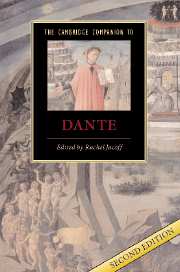Book contents
- Frontmatter
- 1 Life of Dante
- 2 Dante and the lyric past
- 3 Approaching the Vita nuova
- 4 From auctor to author: Dante before the Commedia
- 5 Introduction to Inferno
- 6 Introduction to Purgatorio
- 7 Introduction to Paradiso
- 8 Dante and the Bible
- 9 Dante and the classical poets
- 10 Allegory and autobiography
- 11 A poetics of chaos and harmony
- 12 The theology of the Comedy
- 13 The poetry and poetics of the creation
- 14 Dante and Florence
- 15 Dante and the empire
- 16 Dante and his commentators
- 17 Dante in English
- Further reading
- Index
- Series List
9 - Dante and the classical poets
Published online by Cambridge University Press: 28 May 2007
- Frontmatter
- 1 Life of Dante
- 2 Dante and the lyric past
- 3 Approaching the Vita nuova
- 4 From auctor to author: Dante before the Commedia
- 5 Introduction to Inferno
- 6 Introduction to Purgatorio
- 7 Introduction to Paradiso
- 8 Dante and the Bible
- 9 Dante and the classical poets
- 10 Allegory and autobiography
- 11 A poetics of chaos and harmony
- 12 The theology of the Comedy
- 13 The poetry and poetics of the creation
- 14 Dante and Florence
- 15 Dante and the empire
- 16 Dante and his commentators
- 17 Dante in English
- Further reading
- Index
- Series List
Summary
Introduction: mimesis and literary models
Although all medieval literature in the romance vernaculars may be characterized - even defined - as a sustained, dynamic response to the classical canon, Dante's Divina Commedia is an altogether exceptional case. For, in a variety of fundamental ways, the entire Commedia is built on a series of extended encounters with four Latin poets: Virgil, Statius, Lucan, and Ovid. The Commedia's plot line figures these encounters in four principal (and interrelated) manners. First, Dante-protagonist meets and interacts with all four poets, who are characters in his poem. Second, Dante-protagonist undergoes (and/or witnesses) a series of key experiences that are visibly modelled on narrative events from the Aeneid, the Thebaid, the Pharsalia, and the Metamorphoses. The most important, frequent, and systematic instances of this process involve two alternatives: either Dante-protagonist functions as a new, Christian, Aeneas, modeled on the single protagonist of Virgil's epic; or he functions as a corrected version of one of the many protagonists of Ovid's multi-narrative epic. Third, Dante-protagonist encounters characters from the four Latin epic poems, who serve both to link the Commedia to these authoritative model texts, and to figure their mimetic status within the poetic economy of Dante's work. Certain of these key characters also function as metonymic representations of their “source texts” and are used to comment on them, either implicitly or explicitly. The two most striking instances of this are the group of four diviners (Amphiaraus, Tiresias, Aruns, and Manto) in Inferno 20, and the figure of Cato in Purgatorio 1 and 2. Fourth, Dante-author explicitly names his privileged auctores in various ways as part of the ongoing drama of the writing of the Commedia, which is such an essential element in that first-person narrative.
- Type
- Chapter
- Information
- The Cambridge Companion to Dante , pp. 141 - 160Publisher: Cambridge University PressPrint publication year: 2007
- 3
- Cited by

